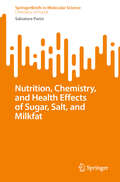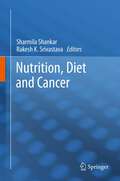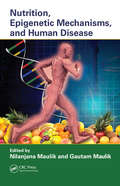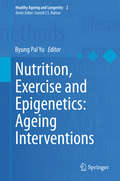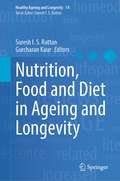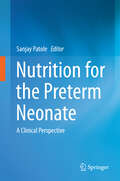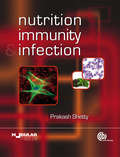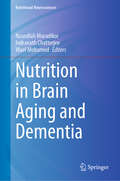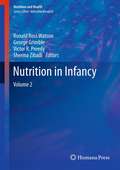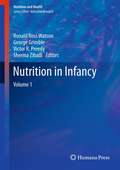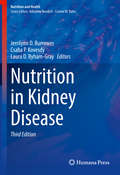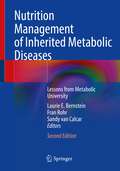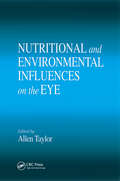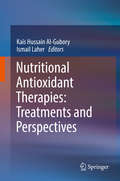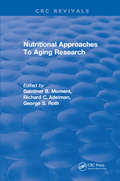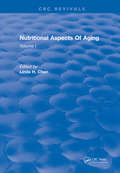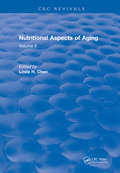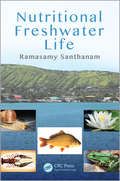- Table View
- List View
Nutrition, Chemistry, and Health Effects of Sugar, Salt, and Milkfat (SpringerBriefs in Molecular Science)
by Salvatore ParisiThis book covers sugar, salt and milk fat from a chemical perspective, and presents an overview of the role of these ingredients in our food, focusing on their flavors, satiety-inducing properties, nutritional impact, and health effects. The book begins with a chapter devoted to the chemical composition of these taste enhancers and satiety-inducing components, followed by a chapter that sheds light on the persuasive tactics employed by the food industry and their impact on consumer behavior, ultimately discussing the complex relationship between marketing strategies and public health. In Chapter 3, the author presents case studies and explores the nutritional requirements of these ingredients, while considering their physiological effects ad potential implications for human health. In Chapter 4, the author evaluates current consumption patterns and their implications, analyzing trends, policies, and opportunities to shape healthier dietary choices. The book closes with a chapter devoted to the effects of glucose, sodium and cholesterol deficiency, where the author discusses the consequences of imbalanced intake or deficiencies in these ingredients and outlines their impact on human health as well as evidence-based recommendations for keeping a balanced diet. Researchers, scholars, and students in the fields of food science, nutrition, chemistry will understand the appeal of this book.
Nutrition, Diet and Cancer
by Rakesh K. Srivastava Sharmila ShankarChemoprevention of cancer has been the focus of intensive research for more than two decades. Epidemiological evidence has shown a small, but significant association between fruit and vegetable intake and a reduction in cancer risk. Diet may account for about thirty five percent of cancer. Large claims have been made for the effectiveness of particular diets in determining one's risk of developing cancer, ranging from protection against cancer initiation, progression and metastasis. A wide array of dietary components has been demonstrated to be as effective in fighting off cancer. Towards an increased understanding of the nutrition, excercise and diet in preventing cancer or inhibiting its progression has led to the discovery and development of novel and effective drugs that regulate intracellular signaling network in the body. This information will be very useful to explore novel and highly effective chemopreventive strategies for reducing the health burden of cancer. Hippocrates, who proclaimed 25 centuries ago, 'Let food be thy medicine and medicine be thy food'. They estimated that one third of all cancer cases could be prevented by a healthier diet; statements which are widely accepted in the scientific literature. This book covers the current state-of-the art knowledge on the impact of nutrition and diet with nutrigenetics, nutritional epigenomics, nutritional transcriptomics, proteomics, and metabolomics approach in cancer prevention and therapy.
Nutrition, Epigenetic Mechanisms, and Human Disease
by Nilanjana Maulik Gautam MaulikAs nutrition research is shifting its focus from epidemiology and physiology to effects of nutrients at the molecular level, a uniquely tailored diet that corresponds to the demands of our genetic signature is emerging as an indispensable need. Using high-throughput genomic tools, nutrigenomics unravels the influence of micro- and macronutrients as
Nutrition, Exercise and Epigenetics: Ageing Interventions
by Byung Pal YuThis book focuses on the three most important aspects of ageing research: nutrition, physical exercise and epigenetics. The contributors discuss ways that age-related epigenetic imprints such as DNA methylation and histone acetylation are modified by these two interventions. The emphasis on epigenetics helps to illuminate the underlying mechanisms of anti-ageing interventions, as ageing and disease are predominately epigenetic phenomena. Among the highlights are chapter-length discussion of such topics as: how anti-inflammatory action of calorie restriction underlies the retardation of ageing and age-related diseases (Chapter 3); epigenetic modification of gene expression by exercise (Chapter 5); the role of functional foods and their bioactive components in bone health (Chapter 8); and an account of the first decade of a study of calorie restriction in nonhuman primates, conducted by the National Institute on Ageing.
Nutrition, Food and Diet in Ageing and Longevity (Healthy Ageing and Longevity #14)
by Suresh I. S. Rattan Gurcharan KaurThis edited volume is a compilation of 30 articles discussing what constitutes food for health and longevity. The aim is to provide up-to-date information, insights, and future tendencies in the ongoing scientific research about nutritional components, food habits and dietary patterns in different cultures. The health-sustaining and health-promoting effects of food are certainly founded in its overall composition of macronutrients and micronutrients. However, the consumption of these nutrients is normally in the form of raw or prepared food from the animal and plant sources. The book is divided into four parts and a conclusion, and successfully convenes the well-established information and knowledge, along with the personal views of a diversified group of researchers and academicians on the multifaceted aspects of nutrition, food and diet. The first part reviews the scientific information about proteins, carbohydrates, fats and oils, micronutrients, pro- and pre-biotics, and hormetins, along with a discussion of the evolutionary principles and constraints about what is optimal food, if any. The second part discusses various kinds of foods and food supplements with respect to their claimed benefits for general health and prevention of some diseases. The third part brings in the cultural aspects, such as what are the principles of healthy eating according to the traditional Chinese and Indian systems, what is the importance of mealing times and daily rhythms, and how different cultures have developed different folk wisdoms for eating for health, longevity and immortality. In the part four, various approaches which are either already in practice or are still in the testing and research phases are discussed and evaluated critically, for example intermittent fasting and calorie restriction, food-based short peptides, senolytics, Ayurvedic compounds, optimal food for old people, and food for the prevention of obesity and other metabolic disorders. The overreaching aim of this book is to inform, inspire and encourage students, researchers, educators and medical health professionals thinking about food and food habits in a holistic context of our habits, cultures and patterns. Food cannot be reduced to a pill of nutritional components. Eating food is a complex human behavior culturally evolved over thousands of years. Perhaps the old adage “we are what we eat” needs to be modified to “we eat what we are”.
Nutrition for Sport and Exercise
by J. Andrew Doyle Marie DunfordTeaching you how to interpret and apply scientific data, Dunford/Doyle's NUTRITION FOR SPORT AND EXERCISE, 4th Edition, emphasizes the scientific basis for sports nutrition recommendations and highlights current research studies of trained athletes. The text helps you translate current nutrition recommendations and guidelines into specific plans for the appropriate amount and type of foods, beverages and/or supplements to support training, performance and recovery--for a variety of sports. Detailed explanations of the connection between exercise and nutrition help you reach the ultimate goals--optimal performance and health. Giving you in-depth insight, entire chapters are devoted to diet planning, disordered eating and exercise patterns in athletes and lifelong fitness and health.
Nutrition for the Preterm Neonate: A Clinical Perspective
by Sanjay PatoleSurvival of extremely premature neonates has improved significantly following the advances in neonatal intensive care. Extrauterine growth restriction is a serious issue in this population. Nutritional exposures during critical period of life influence the individual's risk of disease throughout life. Nutritional deficit and poor growth are associated with long term neurodevelopmental impairment, short stature and metabolic disorders in extremely preterm neonates. Optimising nutrition in the early postnatal life of the preterm neonate is therefore a priority. However this is easier said than done considering the frequency of feed intolerance, fear of necrotising enterocolitis, and the hesitancy in adopting an aggressive approach to parenteral nutrition in this population. Some of the finest researchers in the field have come together to provide the clinical perspective on the A to Z of nutrition in the preterm neonate in simple and clear fashion in this book.
Nutrition Guide for Physicians
by Maria Boyle Struble Norman J. Temple George A. Bray Ted WilsonNutrition Guide for Physicians is a desktop reference guide on nutrition and its clinical implications for health and disease through the lifecycle. Presented in a new softcover format and user-friendly style, it serves as a valuable resource of practical information on nutrition for physicians in their daily practice. Nutrition Guide for Physicians is divided into three parts that cross the spectrum of nutritional concerns for improving the practice of medicine. Part One provides basic nutritional principles for physicians. Part Two covers nutrition through the lifecycle and optimal nutrition patterns through all stages of development. Part Three covers diet and its role in prevention, cause and treatment of disease. All chapters include figures and tables that provide useful descriptive and visual reviews. "Key points" and succinct "conclusions" are also provided for each topic. Nutrition Guide for Physicians provides a wide perspective of the impact that nutrition has upon medical practice and will be am indispensable resource for primary care physicians and other medical professionals.
Nutrition Guide for Physicians and Related Healthcare Professions (Nutrition and Health)
by Norman J. Temple George A. Bray Ted WilsonThis fully updated and expanded third edition is a reference guide on nutrition and its clinical implications for health and disease through the life-cycle. The book endeavors to address the needs of those who would most benefit from up-to-date information on recent advances in the field of nutrition. Written by experts in the field, chapters cover a diverse range of nutritional areas that present a succinct overview of recent thinking and discoveries that have the greatest capacity to aid physicians and other healthcare professionals in improving the nutritional health of their clients. The text is divided into eight parts. Part one and two address the nutrient requirements and special nutrition-related issues for people across all stages of the lifespan—from pregnancy and infancy through the adolescent years to the older adult years. Part three summarizes the role of nutrition in the prevention and management of chronic conditions frequently seen in clinical practice, including obesity, diabetes, bone disorders, coronary heart disease, hypertension, and cancer. Part four describes different dietary patterns (the Mediterranean diet, the DASH diet, the vegetarian diet, and the ketogenic diet). Part five describes nutrition challenges specific to surgery and several different acute diseases and disorders (gastrointestinal disorders, food allergy and intolerance, diseases of the liver and pancreas, kidney disease, eating disorders, bariatric surgery, sarcopenia, and drug interactions with food). Part six looks at different aspects of the diet (coffee, tea, dietary fat, dietary sugars, energy drinks, alcohol, dietary fiber, vitamins, minerals, and the gut microbiome). Part seven examines a range of factors that influence dietary health decisions (creating nutritional behavior change, methods for assessing nutritional status, Dietary Reference Intakes, an overview of the diet and food guides, food labels, and sources of nutrients). Finally, part eight looks at dietary supplements (including the problem of dishonest marketing) and false and misleading information in the area of nutrition. The growing nutritional impact of COVID-19 is discussed throughout the book where appropriate.Nutrition Guide for Physicians and Related Healthcare Professions Third Edition serves as a comprehensive guide that is organized by age/lifespan, nutrition therapy in relation to chronic disease and COVID, diet and its role in prevention, dietary requirements and recommendations, and influencing health decisions for the patient. It is a valuable resource of practical and easy-to-access information on nutrition for physicians, nurses, pharmacists, and others in their daily practice.
Nutrition, Immunity and Infections
by Prakash ShettyInfectious diseases are an important cause of malnutrition. Recurrent infections increase the risk of malnutrition while poor nutritional status results in lowered immune status and predisposes to infectious disease thus propagating the vicious cycle of infection and malnutrition. The nutrition-infection-immunity axis is crucial for both developed and developing countries and is now a central feature of many nutrition and infectious disease courses. Bringing together nutrition and immunology, Nutrition, Immunity and Infections covers the topic in an accessible format for all students of nutrition, medicine and public health. Through his work at the London School of Hygiene and Tropical Medicine, the FAO's Food and Nutrition Division and his current post at the University of Southampton, Professor Shetty has built a reputation to match his wealth of experience in the relationship between nutrition and susceptibility to infection.
Nutrition in Brain Aging and Dementia (Nutritional Neurosciences)
by Nasrollah Moradikor Indranath Chatterjee Wael MohamedThe book provides a thorough examination of the crucial connection between diet, cognitive aging, and dementia using a multidisciplinary approach. It dives into the complex area of neurology, illuminating different forms of dementia, their underlying pathophysiology, and the risk factors related to them. It explains the symptoms, diagnoses, and therapies for dementia. The book explores the effects of dietary elements like protein, micronutrients, and superfoods, demonstrating their potential to protect cognitive function. Additionally, it discusses how critical vitamins like D and B12, natural antioxidants, and trace minerals affect dementia risk and development. The book explains the use of conventional herbal medicine as a supplementary strategy to dementia therapy, evaluating its potential efficacy and safety. The book provides evidence-based advice to professionals, physicians, researchers, nutritionists, and healthcare professionals to understand the nutritional requirements to control dementia.
Nutrition in Infancy: Volume 2
by George Grimble Victor R. Preedy Ronald Ross Watson Sherma ZibadiNutrition in Infancy: Volume 2 is a very useful resource for all clinicians treating and preventing nutritional problems in infants. This volume covers a wide range of topics that support wellness in infants through the prevention and treatment of infectious diseases, malnutrition, and developmental and genetic abnormalities. A variety of chapters deal with nutrients for infants with disabilities, surgery, and other special needs.<P><P> The sections in this volume discuss GI Tract Considerations, Formulas, probiotics, hormones and lipids in the health and disease of infants, and the growth and development of infants. In Nutrition in Infancy: Volume 2, a wide range of nutritional and food related therapies to prevent or ameliorate disease, growth retardation and promote health are outlined. The latest developments in diagnostic procedures and nutritional support are also included. Written by a group of international experts, this volume is an indispensable new reference for clinicians with an interest in the nutrition and health of pregnant mothers and their infants.
Nutrition in Infancy: Volume 1
by Sherma Zibadi Ronald Ross Watson Victor R. Preedy George GrimbleNutrition in Infancy: Volume 1 is a very useful resource for all clinicians treating and preventing nutritional problems in infants. This volume covers a wide range of topics that support wellness in infants through the prevention and treatment of infectious diseases, malnutrition, and developmental and genetic abnormalities. A variety of chapters deal with nutrients for infants with disabilities, surgery, and other special needs. <P><P> Special emphasis is provided for clinicians treating the millions of children in developing countries whose death is promoted by undernutrition or malnutrition. The next sections discuss the health benefits of supplementation and breast feeding and methods to improve use of berast feeding and it's duration. In Nutrition in Infancy: Volume 1, all of these facets of nutrition and nutritional therapy are covered in a precise and practical way. The latest developments in diagnostic procedures and nutritional support are also included. Written by a group of international experts, this volume is an indispensable new reference for clinicians with an interest in the nutrition and health of pregnant mothers and their infants.
Nutrition in Kidney Disease (Nutrition and Health)
by Jerrilynn D. Burrowes Csaba P. Kovesdy Laura D. Byham-GrayThis third edition of this text is organized into seven sections that address the educational needs of dietitians around the world who seek current information about nutritional management of chronic kidney disease (CKD). Part I addresses the differences in the epidemiology of CKD and renal replacement therapy worldwide, such as environmental, ethnic, cultural, political and macroeconomic factors. Part II includes a thorough review of the components of the nutrition assessment, which includes information about psychosocial issues affecting nutritional status in kidney disease and drug-nutrient interactions, and parts III and IV review preventative strategies for common disorders associated with CKD such as hypertension, type 2 diabetes, obesity and cardiovascular disease are provided, and current evidence-based treatment recommendations for the nutrition management of non-dialyzed, dialyzed and transplanted adults are addressed. Part V presents the nutritional concerns of CKD populations with special needs (i.e., pregnancy, infancy, childhood, adolescence and the elderly). The nutrition management of other disorders associated with kidney disease are covered in Part VI; these include protein-energy wasting and the inflammatory response, bone and mineral disorders, nephrotic syndrome, nephrolithiasis, and acute kidney injury. Lastly, Part VII is devoted to cutting-edge research on topics of concern in nutrition in kidney disease such as the gut microbiome including pre- and probiotics, appetite regulation, advanced glycation end products, physical activity and structured exercise, and dietary patterns including plant-based diets. When appropriate, the new clinical practice guidelines in nutrition for individuals with CKD are integrated into the chapters. The third edition of Nutrition in Kidney Disease will be a highly informative resource for nephrologists, nutrition scientists, nutritionists, and researchers and students whose research, practice, and education includes nutrition and kidney disease.
Nutrition Management of Inherited Metabolic Diseases: Lessons from Metabolic University
by Laurie E. Bernstein Fran Rohr Sandy Van CalcarThis text presents a compilation of topics that have been taught at Metabolic University (MU), an interactive, didactic educational program that has trained over 600 metabolic dietitians/nutritionists, physicians, nurses and genetic counselors. This book was created in 2014 for the metabolic community. The 1st edition contains only subject matter covered at Metabolic University; therefore, it is not a comprehensive treatise on Inherited Metabolic Disorders (IMD) but rather a text on the most frequently encountered challenges in IMD nutrition. Each chapter in the book highlights principles of nutrition management, how to initiate a diet, and biomarkers to monitor the diet. Recognizing that there are variations in practice, this book addresses that the key to management lies in the understanding how the inactivity of an enzyme in a metabolic pathway determines which components of the diet must be restricted and which must be supplemented as well as the monitoring of appropriate biomarkers to make diet adjustments and ensure the goals of therapy are met The 2nd edition is an updated and more extensive version covering the nutrition management of IMD, and covers a wide range of these disorders, including phenylketonuria and other aminoacidopathies, organic acidemias, urea cycle disorders, fatty acid oxidation disorders, galactosemia and glycogen storage diseases. Guidance is also provided on laboratory evaluations and biochemical testing and monitoring. Topics such as newborn screening for IMD, as well as nutrition management during pregnancy and transplantation, are also addressed. In addition, current medical management therapies is included.
Nutrition of the Rabbit (2nd edition)
by Carlos De Blas Julian WisemanTopics covered in this authoritative volume include digestive physiology, feed formulation and product quality as well as new contributions on innovative feeding strategies, new methods for feed processing, feed management around weaning and the relationship between nutrition and intestinal health.
Nutrition Physiology and Metabolism in Spaceflight and Analog Studies
by Martina Heer Jens Titze Scott M. Smith Natalie BaeckerThis book provides an overview of microgravity-induced changes in human metabolism, muscle, bone and the cardio-vascular system, and discusses in detail the nutrient uptake required during spaceflight to counteract these adaptive mechanisms and ensure an improved physical constitution upon returning to Earth. It addresses the needs of professors, researchers and students working in the field of human physiology and nutrition.
Nutritional and Environmental Influences on the Eye (Modern Nutrition Ser.)
by Allen TaylorSignificant advancements in nutrition's impact on the eye have occurred faster than any volume can document... until now. This book gives the background and rationale regarding the physiological damage caused by biological oxidants as well as the rationale for the protective roles for nutrient-antioxidants and how they affect the risk for cataracts. This volume also contains information on how to quantitatively assess age-related diseases of the eye including cataracts and age-related maculopathy. Smoking and light exposure as factors for age-related eye diseases as well as the utility of potential anticataract pharmaceuticals is discussed.
Nutritional and Physiological Functions of Amino Acids in Pigs
by Francois Blachier Guoyao Wu Yulong YinThis book provides developmental data regarding piglets (with a focus on the gastrointestinal tract), data related to amino acid metabolism in pigs, data related to nutritional and physiological functions of amino acids in pigs, nutritional requirements for amino acids in pigs, signaling roles of amino acids, methodological aspects in amino acid research and the pig model for studying amino acid-related human diseases.
Nutritional Antioxidant Therapies: Treatments and Perspectives
by Kaïs Hussain Al-Gubory Ismail LaherThis book offers a collection of expert reviews on the use of plant-based antioxidant therapies in disease prevention and treatment. Topics discussed include the uses of plant and nutritional antioxidants in the contexts of reproductive health and prenatal development, healthcare and aging, noncommunicable chronic diseases, and environmental pollution. The text is complemented by a wealth of color figures and summary tables.
Nutritional Approaches To Aging Research
by Gairdner B. Moment Richard C. Adleman George S. RothThe general plan of this volume, Nutritional Approaches to Aging Research is for each chapter to present first a reasonably succinct state-of-the-art appraisal of present knowledge in the particular field or problem covered. This will vary considerable depending on the subject matter. Following this, each chapter will focus on the problems and pitfalls, both conceptual and technological, of work in the particular field and, no less important, present some of the opportunities and implications of work in that particular area.
Nutritional Aspects Of Aging: Volume 1
by Linda H. ChenThe first section in Volume 1 describes the fundamentals of nutrition and aging which include research strategies for the study of nutrition and aging. The nutritional modulation of the aging process which has provided a major breakthrough in the field of nutrition and longevity is also discussed. These include biomedical influences, and social and psychological aspects. Section 3 includes dietary characteristics of the elderly population and methods for the assessment of nutritional status. The nutritional status of the elderly with respect to individual nutrients as determined by dietary survey and by biochemical methods is described in Section 4. Section 4 also includes discussion on nutrient metabolism, requirements, nutritional imbalances, and deficiencies of nutrients. Energy metabolism and obesity as a factor in pathogenesis of diseases are also discussed.
Nutritional Aspects Of Aging: Volume 2
by Linda H. ChenIn the first section of Volume 2, toxicological factors affecting nutritional status are discussed. Medications and alcohol may affect nutritional status. Section 2 provides a discussion of nutrition-related diseases which occur more frequently among the elderly. Cardiovascular diseases including coronary heart disease and cerebrovascular disease are the leading causes of death in the U.S. The relative importance of cardiovascular diseases, in terms of all deaths for the given age group, rises steadily with age. The death rate from these diseases is 28% for the middle age group (35 to 44) and is 69% for the old age group (age 75 and above. This reflects the continued progression of artherosclerosis with aging. Cancer is the second leading cause of death in the U.S. The death rate from cancer also rises steadily with age. The death rate from diabetes mellitus increases progressively with age and more rapidly after the age of 45. The incidence of diabetes mellitus is 0.23% under age 25 and 6.2% over 45.
Nutritional Epidemiology of Breast Cancer
by Alvaro Luis Ronco Eduardo De StéfaniThe book is the first one published exclusively on the field of nutritional epidemiology of breast cancer. It summarizes the currently existing knowledge, with an updated and comprehensive international bibliography (~ 1.000 references). The authors also performed a review on the epidemiological studies on nutrition and breast cancer carried out in Uruguay between 1994 and 2011, which allowed exploring and identifying the main risk and protective factors for the disease in this high-risk country. Epidemiologists, Nutritionists, Public Health managers and breast specialists -from the prevention to the treatment fields - will find in this book a unique source of technical information, which will contribute in expanding their knowledge and view of the disease.
Nutritional Freshwater Life
by Ramasamy SanthanamSupplying sustenance for millions of the poorest people in the world, freshwater flora and fauna also contribute to overall economic well-being by means of export commodity trade, tourism, and recreation. As sources of high-quality nutrients, freshwater flora and fauna of edible value represent a viable option for alleviating the problems related t
